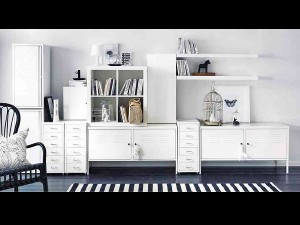
THE MOST fascinating products in Ikea’s line are anything that have to do with storage—cabinets, trunks, drawer chests, bathroom vanities, kitchen racks, pen holders, children’s toy racks and bins. Name it, they have it, in a variety of ways. Photo courtesy of IKEA
When I first moved to Hong Kong some 20 years ago, I was appalled by the sizes of the apartments, and more so, the sizes of the bedrooms they were provided with. Friends who had moved there earlier had forewarned me that bedrooms were sized at 2 meters by 2 and a half meters. I thought they had a terrible sense of scale! But they were right. My first kitchen, in a flat I shared with a Scottish woman was a mere meter and a half squared. But we had all the things we needed to make a decent meal, except that we didn’t have enough space for both of us to be in the kitchen at the same time.
While human mass is absolute, furnishings are not. It took a few weeks, in my disbelief, to settle in, as I grew up in a home that wasn’t fancy, but wasn’t small. Eventually, I realized that small spaces, given the proper appointments, could be very livable. My first foray into furnishing on my own budget—I had mom and Dad’s budget back home but not here where I declared my independence—was stretched with a trip to an Ikea store, which was then and now the value-for-money go-to place for expatriates and other workers from overseas; and even for local residents who lived in small spaces.
My first impression of an Ikea store was that of awe. Awe and wonder at how one place could have so many things, not just in quantity but also in the variety of product types and in the diversity of designs. So, my first hour of having to find a free-standing closet and a proper console for my stereo system stretched-out to four hours, three of which were for browsing the store, and the last hour, for making sound decisions on which items to actually buy.
The concept of Ikea was born out of its founder, Ingvar Kamprad, and his love for making furniture that is functional yet beautiful. Kamprad lived in the town of Smaland in southern Sweden, where he started his furniture enterprise in the late 1940s. Typical of the Scandinavian discipline and aesthetic, his pieces were functional, simple and visually pleasing. As his business grew, he took it a step further and looked into maximizing the materials he was using. He devised ways to exploit standard panel sizes in order to cut down on material wastage.
Cutting costs
He also looked into how to assemble and disassemble pieces such that they could be packed into the smallest carton possible, with the least use of padding and wrapping. With that, he managed to keep their costs low.
Eventually, the discipline of cutting costs has been the beacon for how the company develops its products, from design and production, delivery and transport, to stocking and warehousing, sales and assembly. The buyer himself helps the cost cutting, because he will eventually assemble the product. The name Ikea is from Ingvar Kamprad’s initials of I and K, while E and A stand for Elmtaryd and Agunnaryd, the names of the little southern Swedish farm and town he hails from.
Ikea is a one-stop shop. And I mean that in every way possible. While other furniture manufacturers limit themselves to selling large pieces of furniture, Ikea has expanded practically into anything you need to put into your home and sell them all supermarket style: Come into the store, take a cart and load it up. Pay as you exit. But wallets beware, their collection is so huge, it only makes sense to spend time browsing through their catalogue before being fully immersed and getting lost in their store.
There is an array of attractive yet fairly inexpensive merchandise: beddings, curtains, candelabra, flatware, bath rugs, plates, table napkins, lighting fixtures, bath accessories, photo frames, carpets, cookware, the list goes on and on. They even sell packs of screws, nails and other small hardware. I guarantee you will find yourself buying things you don’t need. The most fascinating products in their line are anything that have to do with storage—cabinets, trunks, drawer chests, bathroom vanities, kitchen racks, pen holders and children’s toy racks. Name it, they have it, in a variety of ways.
For shopping ease, their catalogue is available upon entry at the store. It comes with prices and details sizes and colors, informs you of what you can pullout from a store rack, or what you need to request for at the checkout with the item tag number as reference; plus the many other details you will need know before purchasing. The catalogue will also help you narrow down choices and reduce the time spent looking for the items you already know you need.
Ikea products are functional and simple, with prices that are affordable. They make the most out of small spaces and yet they are attractive and easy to use. They show us that it is possible to have good design and function at friendly prices. Undeniably the world’s leading home furnishings brand, Ikea has more than 330 stores in 40 countries. In Asia, it can be found in Thailand, Singapore, Japan, Malaysia, Australia, Taiwan, China and Hong Kong. While there are Ikea resellers in Manila, the Philippines has no official distributor or franchise. So with the property market booming and the condominium units flourishing, will we be the next? Your guess is as good as mine. We are ripe, and I am eager.
Contact the author through designdimensions@abi.ph or through our Asuncion Berenguer Facebook account.

